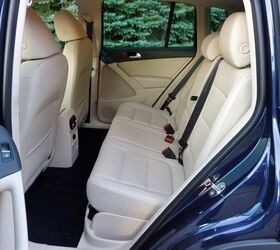For car enthusiasts needing to balance personal driving desires with family-friendly practicality, the compact crossover segment offers a compelling compromise. While some might yearn for the agility of a hatchback, the utility and perceived style of a crossover often win out. In this arena, the Volkswagen Tiguan has been a European contender. Let’s delve into a review of the 2012 Volkswagen Tiguan Sel to see how it holds up, especially when compared to rivals like the Mazda CX-5 and Ford Escape.
The 2012 model year brought a facelift to the Tiguan, yet it couldn’t completely mask its aging design. While Volkswagen aimed to align its appearance with their contemporary aesthetic through a more refined grille and LED headlight accents, the fundamental silhouette remained. This included the familiar long hood, boxy cabin, and truncated rear. Even when initially introduced, the Tiguan’s design prioritized function over outright beauty. Its chunky exterior aimed to project an image of sportiness and rugged capability, appealing to buyers seeking a crossover that looked the part.
Inside, the 2012 Tiguan SEL received updates intended to elevate the ambiance, though the core character of the cabin remained focused on functionality rather than lavish design. The controls are straightforward, a refreshing contrast to the often complex interfaces found in modern vehicles. Everything is within easy reach and intuitive to operate. The driving position is notably upright, offering a more SUV-like feel compared to newer, car-based crossovers. Depending on driver preference, this higher seating position can be seen as advantageous. The dashboard design appears somewhat tall, possibly intended to evoke a truck-like sensation, yet it doesn’t intrude excessively into the cabin space. Raising the seat provides good forward visibility. Rear visibility, while not exceptional, is better than some of its more aggressively styled competitors. It’s worth noting that features like a rearview camera or blind-spot monitoring were not offered on this model, which is a significant omission by today’s standards.
Despite the facelift, the 2012 Tiguan remains one of the more compact options within the compact crossover category. Its wheelbase and overall length are shorter by several inches compared to the then-new Mazda CX-5 and Ford Escape. However, this difference in exterior dimensions doesn’t drastically compromise passenger space. While official specifications might suggest a considerable difference in legroom compared to the CX-5, real-world experience indicates that rear legroom is surprisingly comparable in both vehicles. A key advantage of the Tiguan’s rear seats is their ability to slide and recline, enhancing passenger comfort, a feature not found in the Mazda CX-5.
Cargo space is where the Tiguan reveals its more compact nature. While the discrepancy might not be as substantial as the official figures suggest, it’s undeniable that the Tiguan offers less cargo room than the Mazda CX-5 and Ford Escape. A somewhat unique feature, though not available on the SEL trim, is the folding front passenger seat, which can partially compensate for the limited cargo area in lower trims.
Interestingly, the Tiguan, despite its German engineering and manufacturing, exhibits the least “European” driving dynamics among its contemporaries. The steering feel is relatively light, especially on center, and remains so in various driving situations. The suspension and seats lean towards the softer side, prioritizing comfort, although they are still firmer than what you might find in a Honda or Toyota. Handling is competent and inspires confidence, but it doesn’t deliver a particularly sporty experience. It’s more akin to a comfortable, raised Rabbit than a GTI with increased ground clearance.
However, the 2012 Volkswagen Tiguan SEL holds a distinct advantage in powertrain. While both the Tiguan and CX-5 offered a single engine choice at the time – a 2.0-liter four-cylinder – the Tiguan’s engine is turbocharged, producing a robust 200 horsepower compared to the Mazda’s 155. This power difference translates to noticeable gains in straight-line performance, even in everyday driving. Where the Mazda engine could feel strained under load, the Tiguan’s turbocharged engine rarely exhibits such behavior.
Fuel economy ratings from the EPA position the Tiguan as less fuel-efficient than the Mazda CX-5. However, real-world observations suggest that the gap in fuel economy might be smaller than indicated, especially in suburban driving conditions. Considering the Tiguan’s more powerful engine and available all-wheel-drive, its real-world fuel consumption figures are arguably quite respectable.
One area where the Tiguan’s powertrain falls short is the transmission. Unlike some other Volkswagen models, the 2012 Tiguan SEL doesn’t feature the quick-shifting DSG transmission. Instead, it utilizes a conventional six-speed automatic transmission sourced from Aisin. This transmission can sometimes exhibit less-than-smooth behavior, with occasional lurching, engine lugging, or seemingly unnecessary gear changes.
While the Tiguan’s handling might not be overtly sporty, its pricing aligns with typical German vehicles – meaning it can be on the higher side. The tested 2012 Tiguan “SE AWD with Sunroof and Navigation” carried a list price of $33,300. Opting for the SEL trim would push the price even higher. In comparison, a similarly equipped Mazda CX-5 was significantly less expensive. Furthermore, the Mazda offered features like leather upholstery, larger wheels, a premium Bose audio system, power driver’s seat, keyless entry, blind-spot monitoring, rearview camera, and more – all at a lower price point. Adjusting for the feature differences reveals a substantial price advantage for the Mazda.
Despite some of these shortcomings, particularly in value and cargo space, the Tiguan can still appeal to certain buyers. Its comfortable ride, upright driving position, and more compliant suspension might be preferred by those prioritizing comfort over sporty handling. While driving enthusiasts might find it less engaging, the average crossover buyer, focused on daily usability and comfort, might find the 2012 Volkswagen Tiguan SEL a satisfactory choice. However, the higher price point remains a significant factor to consider when weighing its pros and cons against more value-oriented competitors.
